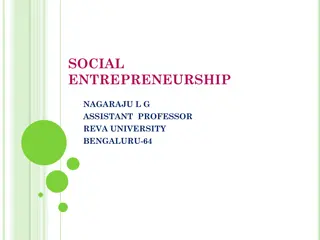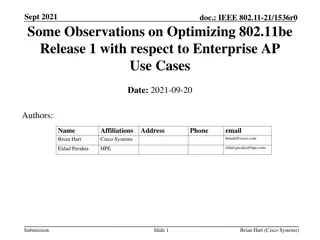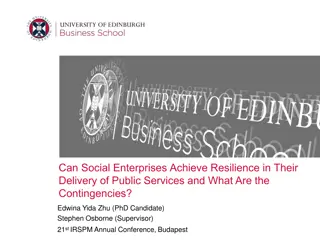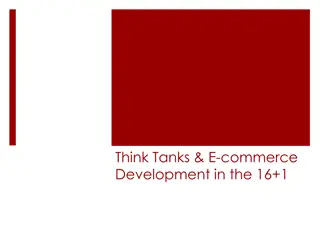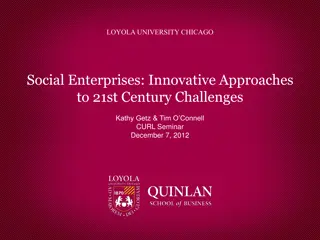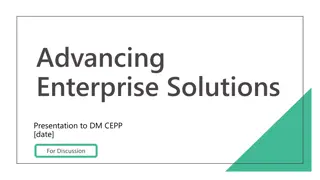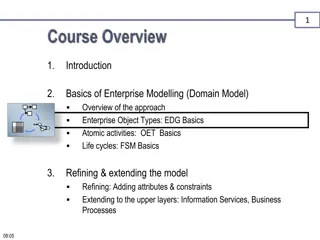
Transitioning to Social Enterprise: Key Considerations and Benefits
Discover essential points to ponder when transitioning to a social enterprise, including motivation, commitment, transparency, shared ownership, social impact, fair and sustainable practices, and more. Uncover the benefits for your business, such as highlighting social impact, fostering sustainability, and accessing new opportunities. Embrace the shift to a mission-driven model that prioritizes societal well-being and inclusivity.
Download Presentation

Please find below an Image/Link to download the presentation.
The content on the website is provided AS IS for your information and personal use only. It may not be sold, licensed, or shared on other websites without obtaining consent from the author. If you encounter any issues during the download, it is possible that the publisher has removed the file from their server.
You are allowed to download the files provided on this website for personal or commercial use, subject to the condition that they are used lawfully. All files are the property of their respective owners.
The content on the website is provided AS IS for your information and personal use only. It may not be sold, licensed, or shared on other websites without obtaining consent from the author.
E N D
Presentation Transcript
FIVE THINGS TO THINK ABOUT WHEN TRANSITIONING TO SOCIAL ENTERPRISE
FIRST CONSIDERATIONS 1. Motivation Think carefully about the reasons why you feel this transition is the right one for your business 2. Commitment Social enterprises are mission driven businesses, not driven by profit for private gain. 3. Transparency Social enterprises share their knowledge, success, failure, finances and impact so that everyone can see what they are doing and how they work. 4. Shared ownership Social enterprises are not working for individual gain. They are working for a fairer society.
MY TOP FIVE Benefits for the business: Highlighting an organisation's social impact evidencing the difference the work can make for communities and society Making business fairer and more sustainable Access to new economic opportunities, social investment and support Opportunities for membership of networks such as SEUK, working together to transform the business landscape Easy options for amending or changing the legal structure.
1 SOCIAL IMPACT Social impact reporting and publishing Define social mission Consumers, audiences and supporters may base their choices to work with you on evidence of the social impact that your work achieves, the social/environmental change Identifying the objectives of your mission and the changes/impact it will achieve are the key drivers for the business. The social impact of your business will be important to the values and culture of your business, which you will want to reflect in your mission. Evidence of the success (or failure) of your business to meet the social mission can guide the business to adapt and change as necessary.
2 FAIR AND SUSTAINABLE BUSINESS Social enterprises currently contribute around 60 billion to the UK economy. They are at the forefront of transparency and inclusiveness in their business values They use their profits to drive down inequality and increase social justice both for employees, customers and localities. Social enterprises are more representative of wider society and leaders in delivering equality and diversity. Social enterprises come from every sector of the UK economy sometimes working in the most deprived areas of the UK increasing economic growth and supporting social change. Social enterprises are leading other SMEs in the battle to reduce climate change, working towards sustainable and environmentally sound business and working practices. Social enterprises are at the forefront of inclusivity in staff and beneficiary involvement in decision making and service delivery.
3INCOME AND FINANCE Transitioning to social enterprise may mean rethinking the profit motives of your business. Reinvesting your profits in your social objectives doesn t mean giving your money away to charity (usually). It means putting your profits back into the business to enable it to grow and thrive for the benefit of community and planet. As a CIC limited by guarantee some grants may be available and social investors may be more inclined to support an asset locked business. An Employee ownership trust model may attract tax incentives, but you would need to consult the Employee Ownership Association to understand the options Home Employee Ownership Association Social investment is a growing option for developing social enterprise businesses. General recognition that social inequality and the climate crisis can only be tackled with businesses and industry involved in that process. This has seen some increase in the drive to support and grow social enterprises. More is needed!
4 NETWORKS AND SUPPORT ORGANISATIONS Walt Disney Join SEUK so that you can meet and share with other social enterprises: a) Join SEUK which offers accreditation (there are other options). b) Promote and declare the mission and vision and the social impact you aim to achieve in social media c) Work with other social enterprises to encourage areas to become dominated by social enterprise businesses. (SEUK Places is one such programme.) d) Social enterprises are open and transparent businesses willing to work together and support each other, networks help with that process. e) There are a number of network support organisations: the Co-operatives UK, Locality, Power to Change. Local area networks: Social Enterprise Kent. Social Enterprise East of England.
5 OPTIONS FOR THE TRANSITION Legal structure options a) Amend existing Articles of Association to include a social objectives clause. b) Change the Articles of Association to include various clauses, you can use a website: Purposely (getpurpose.ly) which offers a range of models for CLS companies, some to limit profits for shareholders and other options. c) Convert to a CIC d) Convert to a Community Benefit Society e) Convert to Employee ownership Trust or scheme. f) Set up a separate company, such as a CIC, to deliver social objectives.
SOME REFLECTIONS It can be difficult to choose the right legal structure. There are multiple routes to social enterprise resulting in changes to governance and viability. The transition of the culture and values of a business can be harder to grasp and their importance at the early stages overlooked. Across the business community and governments awareness of the potential of transition to social enterprise is often lacking. There can be commercial benefits and occasionally tax incentives The asset lock in CIC models can be a disincentive. Access to alternative finance options can be difficult to understand because of the variety and variation available. The process can be costly if complex options are perceived necessary. Time and guidance are not easily identified
Social Investment Business (sibgroup.org.uk) Welcome to Good Finance | Good Finance) Apply | Good Market Breadwinners Foundation 2022/2023 Accounts Review: A Year of Resilience and Impact Breadwinners Our Impact | Cockpit (cockpitstudios.org) For general inquiries: membership@socialenterprise.org.uk






